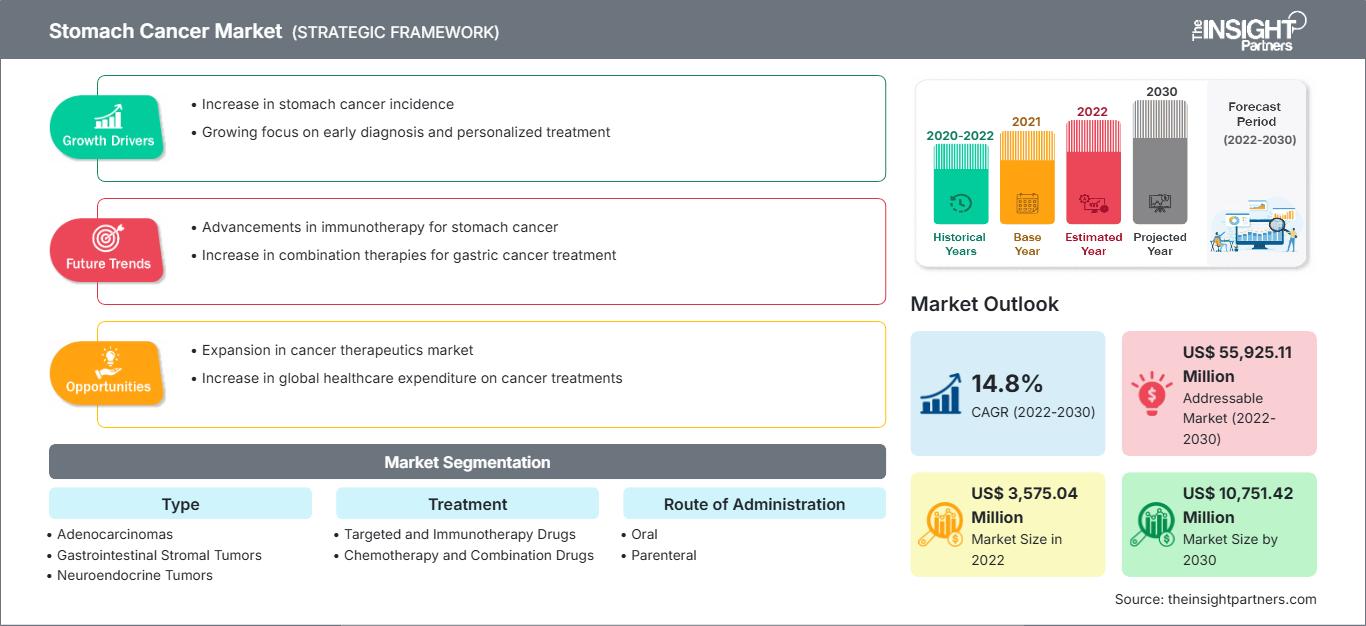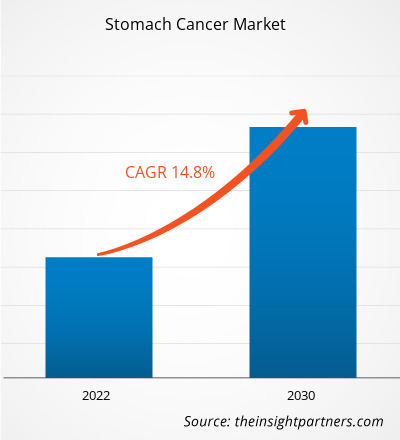[Forschungsbericht] Der Markt für Magenkrebs wird voraussichtlich von 3.575,04 Millionen US-Dollar im Jahr 2022 auf 10.751,42 Millionen US-Dollar im Jahr 2030 wachsen; für den Zeitraum 2022–2030 wird eine durchschnittliche jährliche Wachstumsrate (CAGR) von 14,8 % erwartet.
Markteinblicke und Analystenmeinung:
Magenkrebs, auch Magenkarzinom genannt, wird durch das abnormale und unkontrollierte Wachstum bösartiger Zellen im Magen verursacht. Zu den Risikofaktoren, die zu Magenkrebs führen, gehören Alter und Ernährung. Verdauungsstörungen, Magenbeschwerden, Appetitlosigkeit, Sodbrennen und Gewichtsverlust sind alles Symptome von Magenkrebs. Zur Behandlung von Magenkrebs werden verschiedene Ansätze wie Chemotherapie, Strahlentherapie und Immuntherapie eingesetzt. Das Wachstum des Magenkrebsmarktes wird durch Faktoren wie die steigende Inzidenz von Magenkrebs, Fortschritte in der Behandlung, einschließlich Chemotherapie, Chirurgie und zielgerichteten Therapien, sowie laufende Forschungs- und Entwicklungsbemühungen zur Verbesserung der Patientenergebnisse beeinflusst. Da der Schwerpunkt zunehmend auf Frühdiagnose und personalisierten Behandlungsansätzen liegt, wird erwartet, dass der Markt für Magenkrebsbehandlungen auch in Zukunft weiter wachsen wird.
Wachstumstreiber:
Unternehmen im Gesundheitsmarkt unternehmen verschiedene Forschungs- und Entwicklungsaktivitäten, um innovative Behandlungen für Magenkrebs einzuführen. Darüber hinaus werden die Behandlungen in klinischen Studien evaluiert, und es werden ständig neue Ansätze entwickelt und in klinischen Studien untersucht. Einige der Produkte in der Pipeline sind unten aufgeführt:
- Im Dezember 2022 schloss Zhejiang Doer Biologics Co., Ltd eine Kooperationsvereinbarung für klinische Studien mit Merck & Co., Inc., um den Anti-Claudin18.2-Antikörper DR30303 von Doer Bio in Kombination mit der Anti-PD-1-Therapie KEYTRUDA (Pembrolizumab) von Merck bei Patienten mit Magen- oder gastroösophagealem Übergangskrebs zu evaluieren. Im Rahmen der Vereinbarung führte Doer Bio eine experimentelle Studie auf der Grundlage eines einvernehmlich vereinbarten und finalisierten Protokolls durch, um die Sicherheit und Wirksamkeit von DR30303 in Kombination mit KEYTRUDA bei Patienten mit Claudin18.2-positivem, lokal fortgeschrittenem, inoperablem oder metastasiertem Magen- oder gastroösophagealen Übergangskrebs zu untersuchen.
- Im November 2022 gab Triumvira Immunologics präklinische Daten zu seinen experimentellen TAC-T-Zelltherapien CLDN18.2-TAC T und GUCY2C-TAC T sowie Daten zu HER2-spezifischen TAC-T-Produkten bekannt. Das Unternehmen präsentierte aktualisierte Daten zu seinem neuartigen T-Zell-Antigenkoppler (TAC)-T-Zell-Kandidaten, der auf Claudin 18.2 abzielt und zur Behandlung von Magenkrebs eingesetzt werden soll.
- Im September 2022 gab Nuvectis Pharma, Inc. positive Daten für NXP800 in einem präklinischen Xenograft-Modell eines ARID1a-mutierten Magenkarzinoms bekannt. Die Tumorvolumina wurden 28 Tage lang gemessen, nachdem die Mäuse jeder Gruppe entweder mit einem Vehikel oder NXP800 behandelt worden waren. Im Vergleich zur Kontrollgruppe kam es zu einer Tumorregression und einer signifikanten Hemmung des Tumorwachstums.
Die steigende Zahl klinischer Studien trägt daher dazu bei, die Verfügbarkeit von Magenkrebsbehandlungen weltweit zu erhöhen, was sich wiederum positiv auf das Wachstum des Magenkrebsmarktes auswirkt.
Passen Sie diesen Bericht Ihren Anforderungen an
Sie erhalten kostenlos Anpassungen an jedem Bericht, einschließlich Teilen dieses Berichts oder einer Analyse auf Länderebene, eines Excel-Datenpakets sowie tolle Angebote und Rabatte für Start-ups und Universitäten.
Markt für Magenkrebs: Strategische Einblicke

-
Holen Sie sich die wichtigsten Markttrends aus diesem Bericht.Dieses KOSTENLOSE Beispiel umfasst Datenanalysen, die von Markttrends bis hin zu Schätzungen und Prognosen reichen.
Der Markt für Magenkrebs ist nach Art, Behandlung, Verabreichungsweg, Vertriebskanal und Geografie segmentiert. Nach der Art wird der Magenkrebsmarkt in Adenokarzinome, gastrointestinale Stromatumoren, neuroendokrine Tumoren, Lymphome und andere kategorisiert. Nach der Behandlung wird der Magenkrebsmarkt in zielgerichtete und Immuntherapie-Medikamente, Chemotherapie und Kombinationsmedikamente und andere unterteilt. Nach Verabreichungsweg wird der Magenkrebsmarkt in orale, parenterale und andere segmentiert. In Bezug auf den Vertriebskanal ist der Magenkrebsmarkt in Krankenhausapotheken, Einzelhandelsapotheken und Online-Apotheken segmentiert. Geografisch ist der Magenkrebsmarkt in Nordamerika (USA, Kanada und Mexiko), Europa (Frankreich, Deutschland, Großbritannien, Spanien, Italien und übriges Europa), Asien-Pazifik (China, Indien, Japan, Australien, Südkorea und übriger Asien-Pazifik-Raum), den Nahen Osten und Afrika (Saudi-Arabien, die Vereinigten Arabischen Emirate, Südafrika und der Rest des Nahen Ostens und Afrikas) sowie Süd- und Mittelamerika (Brasilien, Argentinien und der Rest von Süd- und Mittelamerika).
Segmentanalyse:
Der Markt für Magenkrebs wird nach Typ in Adenokarzinome, gastrointestinale Stromatumoren, neuroendokrine Tumoren, Lymphome und andere unterteilt. Das Segment Adenokarzinome hielt 2022 einen bedeutenden Marktanteil und wird voraussichtlich zwischen 2022 und 2030 die höchste CAGR im Magenkrebsmarkt verzeichnen.
Basierend auf der Behandlung wird der Markt für Magenkrebs in zielgerichtete und Immuntherapie-Medikamente, Chemotherapie- und Kombinationsmedikamente und andere unterteilt. Im Jahr 2022 hielt das Segment Chemotherapie- und Kombinationsmedikamente einen bedeutenden Marktanteil. Das Segment der zielgerichteten und Immuntherapie-Medikamente wird voraussichtlich zwischen 2022 und 2030 die höchste CAGR auf dem Magenkrebsmarkt verzeichnen.
Basierend auf dem Verabreichungsweg ist der Magenkrebsmarkt in orale, parenterale und sonstige Verabreichung unterteilt. Im Jahr 2022 hatte das orale Segment einen erheblichen Marktanteil und wird voraussichtlich zwischen 2022 und 2030 die höchste CAGR verzeichnen.
Basierend auf dem Vertriebskanal ist der Magenkrebsmarkt in Krankenhausapotheken, Einzelhandelsapotheken und Online-Apotheken unterteilt. Das Segment der Krankenhausapotheken hatte im Jahr 2022 einen erheblichen Marktanteil und wird voraussichtlich zwischen 2022 und 2030 die höchste CAGR verzeichnen.
Regionale Analyse:
Der Magenkrebsmarkt ist hauptsächlich in Nordamerika, Europa, Asien-Pazifik, Süd- und Mittelamerika sowie den Nahen Osten und Afrika unterteilt. Im Jahr 2022 eroberte Nordamerika einen bedeutenden Marktanteil. Die USA hielten 2022 den größten Marktanteil in der Region. Das Marktwachstum in Nordamerika ist auf die steigende Prävalenz von Magenkrebs, die zunehmende Akzeptanz gezielter Krebstherapien und die Verfügbarkeit fortschrittlicher Technologien in Krebsforschungs- und -behandlungszentren zurückzuführen. Die American Cancer Society geht davon aus, dass im Jahr 2023 rund 26.500 neue Fälle von Magenkrebs (15.930 bei Männern und 10.570 bei Frauen) diagnostiziert werden. Rund 11.130 Todesfälle (6.690 bei Männern und 4.440 bei Frauen) werden auf Magenkrebs zurückzuführen sein. Nordamerika ist hinsichtlich der Zugänglichkeit fortschrittlicher technologischer Behandlungsmöglichkeiten zur Krebsbekämpfung gut entwickelt, und die Unternehmen arbeiten hart daran, mit den namhaften Akteuren in der Region zu konkurrieren.
Darüber hinaus wird erwartet, dass die zunehmenden Aktivitäten der Unternehmen bei der Durchführung klinischer Studien zur Entwicklung wirksamer Medikamente für Patienten mit Magenkrebs sowie die zunehmende Einführung und Zulassung von Produkten das Marktwachstum in der Region ankurbeln. Im April 2021 genehmigte die Food and Drug Administration (FDA) Opdivo von Bristol Myers Squibb in Kombination mit Fluoropyrimidin und platinhaltiger Chemotherapie zur Behandlung von Patienten mit fortgeschrittenem oder metastasiertem Magenkrebs und Speiseröhrenkrebs. Daher werden diese Faktoren das Marktwachstum in der Region im Prognosezeitraum voraussichtlich unterstützen.
Magenkrebs
Regionale Einblicke in den MagenkrebsmarktDie Analysten von The Insight Partners haben die regionalen Trends und Faktoren, die den Magenkrebsmarkt im Prognosezeitraum beeinflussen, ausführlich erläutert. In diesem Abschnitt werden auch die Marktsegmente und die geografische Lage in Nordamerika, Europa, dem asiatisch-pazifischen Raum, dem Nahen Osten und Afrika sowie Süd- und Mittelamerika erörtert.
Umfang des Marktberichts zu Magenkrebs
| Berichtsattribut | Einzelheiten |
|---|---|
| Marktgröße in 2022 | US$ 3,575.04 Million |
| Marktgröße nach 2030 | US$ 10,751.42 Million |
| Globale CAGR (2022 - 2030) | 14.8% |
| Historische Daten | 2020-2022 |
| Prognosezeitraum | 2022-2030 |
| Abgedeckte Segmente |
By Typ
|
| Abgedeckte Regionen und Länder |
Nordamerika
|
| Marktführer und wichtige Unternehmensprofile |
|
Dichte der Marktteilnehmer im Bereich Magenkrebs: Auswirkungen auf die Geschäftsdynamik verstehen
Der Markt für Magenkrebs wächst rasant, angetrieben von der steigenden Endverbrauchernachfrage aufgrund von Faktoren wie sich verändernden Verbraucherpräferenzen, technologischem Fortschritt und einem stärkeren Bewusstsein für die Produktvorteile. Mit steigender Nachfrage erweitern Unternehmen ihr Angebot, entwickeln Innovationen, um den Verbraucherbedürfnissen gerecht zu werden, und nutzen neue Trends, was das Marktwachstum weiter ankurbelt.

- Holen Sie sich die Markt für Magenkrebs Übersicht der wichtigsten Akteure
Zahlreiche Initiativen wichtiger Akteure auf dem globalen Magenkrebsmarkt sind nachstehend aufgeführt:
- Im Januar 2021 erhielten AstraZeneca und Daiichi Sankyo Company von der US-amerikanischen FDA die Zulassung für Enhertu zur Behandlung erwachsener Patienten mit fortgeschrittenem oder metastasiertem HER2-positivem Magenadenokarzinom.
Wettbewerbslandschaft und wichtige Unternehmen:
Bristol Myers Squibb Company; Novartis AG; Merck & Co., Inc.; Eli Lilly and Company; Biocon; Teva Pharmaceutical Industries Ltd; Celltrion Healthcare Co., Ltd; Samsung Bioepis; Pfizer Inc.; und Ipsen Pharma gehören zu den führenden Akteuren auf dem Magenkrebsmarkt. Diese Unternehmen konzentrieren sich auf die Einführung neuer Hightech-Produkte, die Weiterentwicklung bestehender Produkte und die geografische Expansion, um die weltweit wachsende Verbrauchernachfrage zu befriedigen.
- Historische Analyse (2 Jahre), Basisjahr, Prognose (7 Jahre) mit CAGR
- PEST- und SWOT-Analyse
- Marktgröße Wert/Volumen – Global, Regional, Land
- Branchen- und Wettbewerbslandschaft
- Excel-Datensatz
Aktuelle Berichte
Verwandte Berichte
Erfahrungsberichte
Grund zum Kauf
- Fundierte Entscheidungsfindung
- Marktdynamik verstehen
- Wettbewerbsanalyse
- Kundeneinblicke
- Marktprognosen
- Risikominimierung
- Strategische Planung
- Investitionsbegründung
- Identifizierung neuer Märkte
- Verbesserung von Marketingstrategien
- Steigerung der Betriebseffizienz
- Anpassung an regulatorische Trends






















 Kostenlose Probe anfordern für - Markt für Magenkrebs
Kostenlose Probe anfordern für - Markt für Magenkrebs